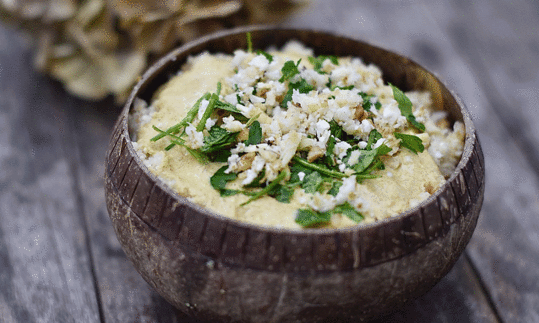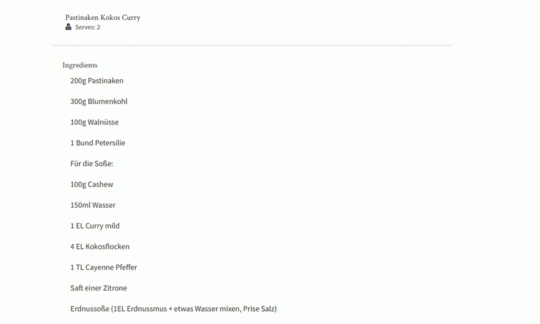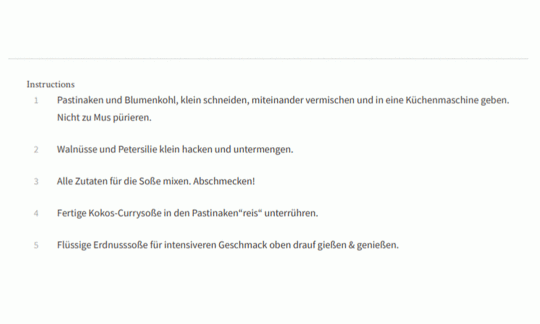Parsnip Coconut Curry with Cauliflower and Walnut
vegan
Ingredients (for servings, )
| For the "parsnip rice" | |
|---|---|
| 7 ⅓ oz | Parsnips, raw (organic?) |
| 11 oz | Cauliflower, raw (organic?) |
| 3 ½ oz | Walnuts (tree nuts), raw (organic?) |
| 1 bunch | Parsley, fresh, raw (leaf parsley, parsley) (1.1 oz) |
| For the coconut curry sauce | |
| 1 | Lemons, raw (limes, organic?) (2.0 oz) |
| 3 ½ oz | Cashew nuts, raw? organic? (cashew nuts) |
| 150 ml | Drinking water, raw (organic?) (5.3 oz) |
| 4 tbsp | Coconut meat, raw (coconut meat, organic?) (1.4 oz) |
| 1 tbsp | Curry powder (organic?, raw?) (0.22 oz) |
| 1 tsp | Cayenne pepper (raw?, organic?) (0.06 oz) |
Equipment
- blender or food processor
- citrus juicer (lemon squeezer)
Type of preparation
- chop or grind
- food preparation without heating
- blend
- squeeze
- season to taste
Preparation
For the "parsnip rice"
Clean the parsnips and cauliflower, chop them up, mix them together and put them in a food processor. Do not puree them.Chop the walnuts and parsley and mix in.
For the coconut curry sauce
Squeeze the lemon. Mix the cashews, tap water, coconut flakes, spices and lemon juice for the sauce. Season to taste!The original recipe uses mild curry powder.
serving
Stir the finished coconut curry sauce into the parsnip rice.Optional: Pour liquid peanut sauce (1 tablespoon peanut butter, a little water, a pinch of salt) on top for a more intense flavor and enjoy.
|
Nutritional Information per person
Convert per 100g
|
2000 kcal | |
|---|---|---|
| Energy | 814 kcal | 40.7% |
| Fat/Lipids | 63 g | 89.6% |
| Saturated Fats | 13 g | 66.3% |
| Carbohydrates (inc.dietary fiber) | 56 g | 20.9% |
| Sugars | 14 g | 15.8% |
| Fiber | 18 g | 71.7% |
| Protein/Albumin | 23 g | 45.6% |
| Cooking Salt (Na:79.9 mg) | 203 mg | 8.5% |
| Essential micronutrients with the highest proportions | per person | 2000 kcal | |
|---|---|---|---|
| Fat | Linoleic acid; LA; 18:2 omega-6 | 23 g | 233.0% |
| Fat | Alpha-Linolenic acid; ALA; 18:3 omega-3 | 4.6 g | 231.0% |
| Min | Copper, Cu | 2.2 mg | 224.0% |
| Min | Manganese, Mn | 3.9 mg | 197.0% |
| Vit | Vitamin K | 136 µg | 182.0% |
| Vit | Vitamin C (ascorbic acid) | 127 mg | 159.0% |
| Vit | Folate, as the active form of folic acid (née vitamin B9 and | 248 µg | 124.0% |
| Prot | Tryptophan (Trp, W) | 0.28 g | 112.0% |
| Elem | Phosphorus, P | 657 mg | 94.0% |
| Prot | Threonine (Thr, T) | 0.81 g | 87.0% |
Detailed Nutritional Information per Person for this Recipe
The majority of the nutritional information comes from the USDA (US Department of Agriculture). This means that the information for natural products is often incomplete or only given within broader categories, whereas in most cases products made from these have more complete information displayed.
If we take flaxseed, for example, the important essential amino acid ALA (omega-3) is only included in an overarching category whereas for flaxseed oil ALA is listed specifically. In time, we will be able to change this, but it will require a lot of work. An “i” appears behind ingredients that have been adjusted and an explanation appears when you hover over this symbol.
For Erb Muesli, the original calculations resulted in 48 % of the daily requirement of ALA — but with the correction, we see that the muesli actually covers >100 % of the necessary recommendation for the omega-3 fatty acid ALA. Our goal is to eventually be able to compare the nutritional value of our recipes with those that are used in conventional western lifestyles.
| Essential fatty acids | per person | 2000 kcal |
|---|---|---|
| Linoleic acid; LA; 18:2 omega-6 | 23 g | 233.0% |
| Alpha-Linolenic acid; ALA; 18:3 omega-3 | 4.6 g | 231.0% |
| Essential amino acids | per person | 2000 kcal |
|---|---|---|
| Tryptophan (Trp, W) | 0.28 g | 112.0% |
| Threonine (Thr, T) | 0.81 g | 87.0% |
| Valine (Val, V) | 1.2 g | 75.0% |
| Isoleucine (Ile, I) | 0.88 g | 71.0% |
| Leucine (Leu, L) | 1.6 g | 66.0% |
| Phenylalanine (Phe, F) | 1.0 g | 65.0% |
| Lysine (Lys, K) | 1.1 g | 58.0% |
| Methionine (Met, M) | 0.35 g | 38.0% |
| Vitamins | per person | 2000 kcal |
|---|---|---|
| Vitamin K | 136 µg | 182.0% |
| Vitamin C (ascorbic acid) | 127 mg | 159.0% |
| Folate, as the active form of folic acid (née vitamin B9 and | 248 µg | 124.0% |
| Vitamin B6 (pyridoxine) | 0.92 mg | 65.0% |
| Thiamine (vitamin B1) | 0.59 mg | 54.0% |
| Biotin (ex vitamin B7, H) | 27 µg | 53.0% |
| Pantothenic acid (vitamin B5) | 2.5 mg | 42.0% |
| Vitamin E, as a-TEs | 3.7 mg | 31.0% |
| Riboflavin (vitamin B2) | 0.28 mg | 20.0% |
| Niacin (née vitamin B3) | 3.1 mg | 19.0% |
| Vitamin A, as RAE | 83 µg | 10.0% |
| Essential macroelements (macronutrients) | per person | 2000 kcal |
|---|---|---|
| Phosphorus, P | 657 mg | 94.0% |
| Magnesium, Mg | 303 mg | 81.0% |
| Potassium, K | 1'623 mg | 81.0% |
| Calcium, Ca | 188 mg | 23.0% |
| Sodium, Na | 80 mg | 10.0% |
| Essential trace elements (micronutrients) | per person | 2000 kcal |
|---|---|---|
| Copper, Cu | 2.2 mg | 224.0% |
| Manganese, Mn | 3.9 mg | 197.0% |
| Zinc, Zn | 6.0 mg | 60.0% |
| Iron, Fe | 8.3 mg | 59.0% |
| Selenium, Se | 19 µg | 34.0% |
| Iod, I (Jod, J) | 5.8 µg | 4.0% |
| Fluorine, F | 55 µg | 2.0% |
The parsnip coconut curry with cauliflower and walnut does not require any cooking.
Nutrient profile: According to GDA guidelines, one portion of this recipe covers far more than the average daily requirement of copper, manganese, vitamin K and vitamin C, folic acid and tryptophan. The ratio of omega-6 to omega-3 fatty acids does not exceed the recommended maximum ratio of 5:1 at 5:1. However, the fat content is very high at almost 100% of the daily requirement.
Health: For health reasons, we have created an alternative recipe with variations in the ingredients. Please read the link behind this motivation: Vegans often eat unhealthily. Avoidable nutritional errors.
Parsnip: The parsnip has a sweet, spicy, sometimes bitter taste. Parsnips are similar to parsley root, but have a milder taste. They not only stimulate the appetite, but also have a diuretic effect.
Cauliflower: Cauliflower is one of the most easily digestible brassicas. The white cauliflower is the most popular of its kind, but it is also available in orange, purple and green. It has a high vitamin C content and is also rich in B vitamins and K vitamins. However, the cooking process means that cauliflower quickly loses many of its nutrients, with around 25% being lost after just 5 minutes of cooking.
Walnut: The real walnut, also called tree nut, has the highest content of linolenic acid (an omega-3 fatty acid that is good for the heart) of all nuts. It is also rich in vitamin E, zinc (an important trace element for the liver and hair, among other things) and potassium.
Cashew kernels (or cashew nuts): Cashew kernels, also called cashew nuts or simply cashews, are a good source of minerals such as magnesium and iron. They have a mild and slightly sweet taste. Cashew kernels are inedible raw because they contain the toxic oil cardol. Cashew nuts sold in stores are therefore either pre-treated with steam or roasted to deactivate the cardol. They are therefore not raw in the true sense of the word. If it says "cashew kernels, raw" on the package, this usually only indicates that the deactivation of the toxic cardol was done with steam rather than through a roasting process. We can only assume that the food is raw if the process is explained in detail and checked. We have therefore declared this recipe as cooked food.
Parsley: Parsley comes in a flat form (used here) and a curly form. The fresh parsley herb has a high content of vitamin K, vitamin C and iron.
Storing parsley: Wrapped in damp kitchen paper and stored in a plastic bag, parsley will stay fresh in the vegetable compartment of the refrigerator for about a week.
Liquid peanut sauce: Pour additional liquid peanut sauce (1 tablespoon peanut butter, a little water, a pinch of salt) on top for a more intense flavor and enjoy.







